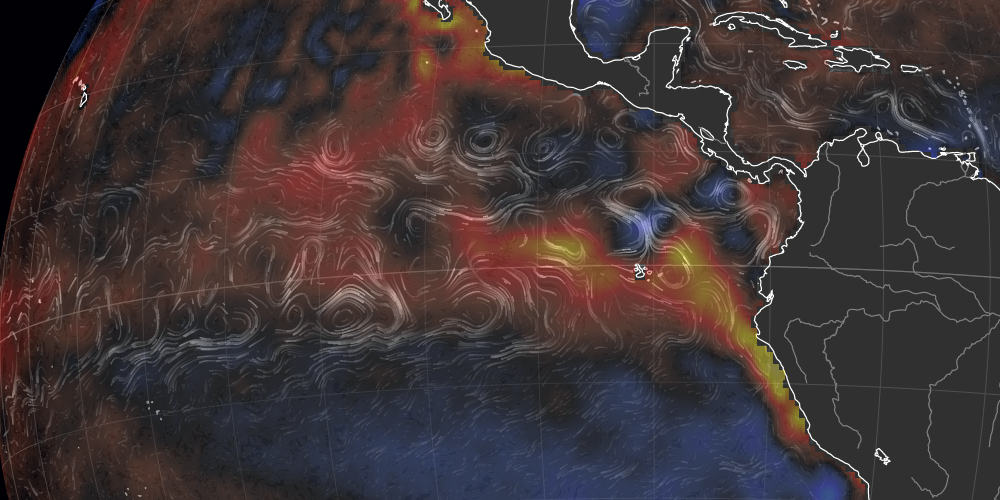The present El Niño event, on the cusp of attaining “strong” intensity, has a chance to become the most powerful on record.
The event — defined by the expanding, deepening pool of warmer-than-normal ocean water in the tropical Pacific — has steadily grown stronger since the spring.
The powerful 2015 #ElNino is continuing to strengthen, just behind the pace set by the record 1997 event #climate pic.twitter.com/LqQf9Ltpae
— Eric Blake 🌀 (@EricBlake12) July 20, 2015
The presence of a strong El Niño almost ensures that 2015 will become the warmest on record for Earth and will have ripple effects on weather patterns all over the world.
A strong El Niño event would likely lead to enhanced rainfall in the U.S. state of California this fall and winter, a quieter than normal Atlantic hurricane season, a warmer than normal winter over large parts of the United States, and a very active hurricane and typhoon season in the Pacific.
Some of these El Niño-related effects have already manifested themselves and, over the U.S., will become particularly apparent by the fall and winter.
Frequent and persistent bursts of wind from the west, counter to the prevailing easterly direction, have helped this year’s El Niño sustain itself and grow. Warm water from the western Pacific has sloshed eastward, piling up in the central and eastern part of the basin.
The sprawling area of warm waters has proven to be a boon for Pacific tropical cyclone activity, near record levels through mid-summer. Through a positive feedback mechanism, these cyclones have likely helped to reinforce the westerly push of warm waters, Slate’s Eric Holthaus reported.
The 2015 El Niño event is now neck-and-neck with record-setting event of 1997-1998 in terms of its mid-summer intensity.
That 1997-1998 event was notorious for its winter flash floods and mudslides in California.
Michael Ventrice, a meteorologist for the Weather Company, said the atmospheric footprint of this year’s event — given the time of year — is statistically extremely rare and has a less than one in 1,000 chance of occurrence.
Colossal El Nino forcing during late July.. AEI rising to >+3.5 sigma!! How rare is a +3.5 sigma event? <0.1% pic.twitter.com/flBn4X9dos
— Doc V (@MJVentrice) July 19, 2015
Although the El Niño is still officially classified as a “moderate” strength event, Tony Barnston, one of the world’s leading El Niño experts, explained it could well become a “strong” event by the end of the month.
“The strength of the departure from normal sea surface temperatures was enough to call it a strong event for just last week,” Barnston, of Columbia’s International Research Institute for Climate and Society (IRI), said. “But to call it an officially strong event, we need for it to stay at that level or higher for a full month. And the average for July could make it.”
The large group of El Niño models, both dynamic (based on physical processes) and statistical (based historical data), mostly forecast at least a strong event — likely to peak in the fall. Collectively, the IRI described the model simulations as “off-the-charts”:
“[El Niño] is growing and the prediction models say it’s going to get stronger,” Barnston said. “And that’s our prediction, that it will become a strong event, most likely.”
A few models, notably the European model and the National Weather Service CFS model, point to the possibility of a near-record event in which a very strong or “super” El Niño develops.
The only two super (or very strong) El Niños in the historic record occurred in 1982-83 and 1997-98.
Recent biases in ECM SST forecasts suggest max of 2.2-2.3 deg anoms, close to 82-83 & 97-98 strength pic.twitter.com/fJo2yOvavI
— Todd Crawford (@tcrawf_nh) July 15, 2015
Perhaps hinting at an El Niño rivaling history, models have been trending stronger with their forecast month after month after month — as they absorb more data reflecting the true state of the current event and how it’s evolving.
While some models show El Niño possibly maxing out in record territory, NOAA climate analyst Michelle L’Heureux expressed some skepticism about such projections in an interview with Mashable’s Andrew Freedman. “L’Heureux noted that none of the major forecasting centers responsible for monitoring El Niño are predicting a record event at this time,” Freedman reported.
NOAA says the “forecaster consensus” is for a strong event but doesn’t specify how strong. Its forecast calls for El Niño to persist through the winter (90 percent chance) and early spring (80 percent chance).
Recommended: The Guardian names Costa Rican journalist among ‘young climate campaigners to watch’ ahead of Paris 2015
© 2015, The Washington Post








